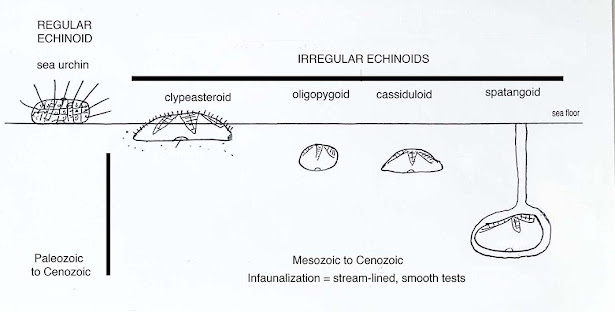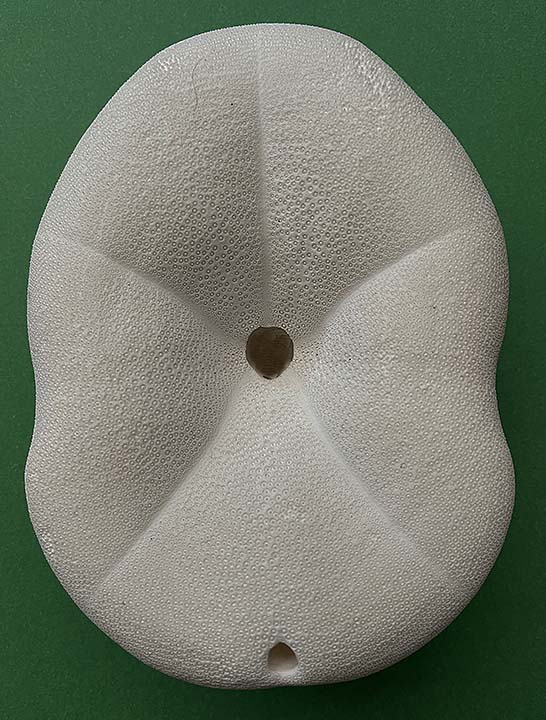NOTE: I have three previous posts about echinoderms:
Jan. 7, 2017-the spatangoid Schizaster diabloensis
Feb. 12, 2019- a two-part series: The first part is about regular echinoids (e.g., spiny sea urchins). The second part is a brief review about the infaunalization of irregular echinoids (sand dollars and some other infaunal groups).
This present post deals ONLY with clypeasteorids (= a main component of the echinoids) and provides much more information, as well as some taxa not mentioned in my 2019 posting.
CLASS ECHINOIDEA
There are two main groups of this class: echinoids = 1) regular (sea urchins) and 2) irregular (sand dollars and other infaunal groups). The mode of life for each of these two groups is shown in the following figure.
Geologic time and life zones of regular and irregular echinoids.Irregular echinoids range from Mesozoic to modern day. Although some irregular echinoids (sand dollars = clypeasteroids) crawl around (epifaunal animals) on the ocean floor, most of them are shallow-depth burrowers (infaunal animals), in either shallow or slightly deeper waters. Becoming burrowers protected them from predators (fish, crabs, etc.). Other infaunal groups that could burrow even deeper,” namely oligopygoids, cassiduloids, and spantagoids will be discussed and illustrated in my next post.
Clypeasteroids = SAND DOLLARS (Epifaunal or Shallow-Infaunal Burrowers)
Order Echinolampadacea
Family Mellitidae
Common Name: Giant Keyhole sand dollar (it has a large hole (keyhole).
Range: Subtropical, Gulf of California, (e.g., Bahia de Los Angeles, Baja California, Mexico).
Habitat: Sandy beaches commonly about 2 m depth (intertidal) but can live to 20 m (394 feet) deep.
Shell: Its keyhole (or lunule = a large opening) allows faster movement of the shell as the animal plow through sand.
Sources of Information: WoRMS (online: World Register of Marine Species), and mexican-fish.com
Figured Specimen: length 7 cm, width 7 cm.
Order Clypeasteroida
Family Mellitdae
Common Name: The “five-slotted” sand dollar.
Range: Endemic to the western Atlantic Ocean, from Virginia to Florida (e.g., especially common in Naples area, Florida), Gulf of Mexico to Texas, south to Mexico, and also Bermuda, Jamaica, Puerto Rico, and Brazil.
Habitat: A temperate to tropical sand dollar that lives in shallow waters below tide lines in sandy bottoms; especially in bays. The five “slots” (openings = lunules) allow for passage of sand during shallow burrowing by the animal.
Source of Information: animaldiversity.org
Figured Specimen: length 7 cm, width 7.2 cm.
Rotuloidea fimbriata Etheridge, 1872 (top view)
Order Clypeasteroida
Family Rotulidae (consists of two extant genera and one extinct genus)
Range: Safi, Morocco, West Sahara [North Africa],
Fossil: Pliocene (approx. 2.5 million years ago).
Habitat: Probably lived in lagoons and estuaries.
Dimensions of Figured Specimen: Length 3.3 cm, width 3 cm.
Astrodapsis bajasurensis Squires and Demetrion, 1993
(two views: top and bottom)
Order Clypeasteroida
Family Echinarachiidae
Range: Baja California Sur, Mexico.
Fossil: Late middle Miocene (Isidro Formation) (approx. 13 million years ago).
Habitat: Subtropical.
Source of Information: Squires and Demetrion, 1993.
Dimensions of Figured Specimen: Length 2.9 cm, width 2.65 cm
Other Comments: The clypeasteroid genus Astrodapsis is endemic to California (Hall, 1962) and Baja California, Mexico (Squires and Demetrion, 1993). It is an index fossil used for relative age-dating of Miocene and Pliocene sedimentary deposits in these areas. Specimens are usually abundant and easily identified to the genus level, at least, based their inflated petals (petaloids), which are food grooves on the top surface of their shell. Species identification of Astrodapsis can be “tricky” however, because of gradational morphology caused by subtle paleoenvironmental differences (note: many nearshore fossils [e.g., oysters] have suffered the same fate). It is extremely likely that there has been considerable over-naming of the California species.
Dendraster excentricus (Eschscholtz, 1831)
(two views top and bottom)
Order Clypeasteroida
Family Dendrasteridae
Range: Alaska to Baja California Sur, Mexico.
Habitat: Tidal channels and protected areas with moderate water movement (e.g., lagoons).
Source of Information: Wikipedia and gbif.org/species/2279084.
Figure 5: Dimensions of Figured Specimen: Length 5.8 cm, width 6.2 cm; this specimen was collected from by the author from beach drift on San Quintin Beach, Baja California Norte.
Note: The food-channeling, very narrow grooves on the bottom of this shell have been stained black by natural causes.
?Dendraster excentricus
This sand dollar population inside the "plastic bubble" has a vertical-feeding position. This image was taken of an exhibit at the Cabrillo Beach Museum, southern California. These sand dollars are in their feeding position; namely, they periodically they align their shells vertically and orient their ventral sides (that is where their mouth is located) facing the current caused by an incoming tide, so as to catch any available suspended food. Typical diameter of this sand dollar is about 8 cm.
Clypeaster rosaceus (Linnaeus, 1758).
(three views top, bottom, and side)
Order Clypeasteroida
Family Clypeasteridae
Common Name: The “flat” sea biscuit.
Range: Western Atlantic Ocean, South Carolina to Barbados, Caribbean, and Panama.
Habitat: Turtle grass and sand fields bordering turtle grass.
Shell: Its variation in shape is great.
Source of Information: Wikipedia.
Dimensions of Figured Specimen: Length 11.4 cm, width 8.6 cm, height 3.5 cm.
Other Comments: The clypeasteroid genus Clypeaster (illustrated above) has considerable variation in the shape of its species. This variation can be in one or more of the following: its petals can be low or inflated; overall shape can be low conical to highly conical. Such variation has undoubtedly resulted in overnaming of species.
Clypeaster sp.
(three views: top, bottom, and side)
Order Clypeasteroida
Family Clypeasteridae
Range: THIS IS A FOSSIL SPECIES. MIOCENE, ITALY
Shell: This highly conical shell shape is quite a contrast to the previous example of a species of this genus; namely, Clypeaster rosaceus = a flat-shell species of this genus.
Dimensions of Figured Specimen: length 12.5 cm, width 11.5 cm, height 6 cm.
References Cited:
Hall, C.A. Jr. 1962. Evolution of the echinoid genus Astrodapsis. University of California Publications in Geological Sciences 40(2):47–180.
Squires, R.L. and R.A. Demetrion. 1993. A new species of the clypeasteroid echinoid Astrodapsis from the Miocene Isidro Formation, Baja California Sur, Mexico. Journal of Paleontology 67(2):258–263.















No comments:
Post a Comment